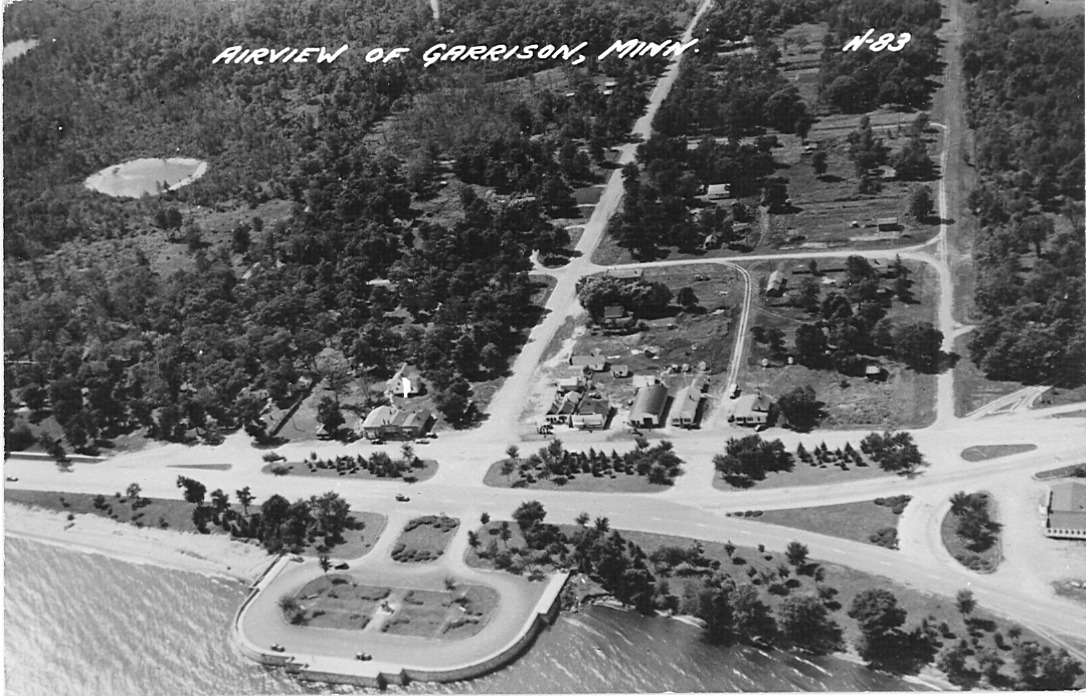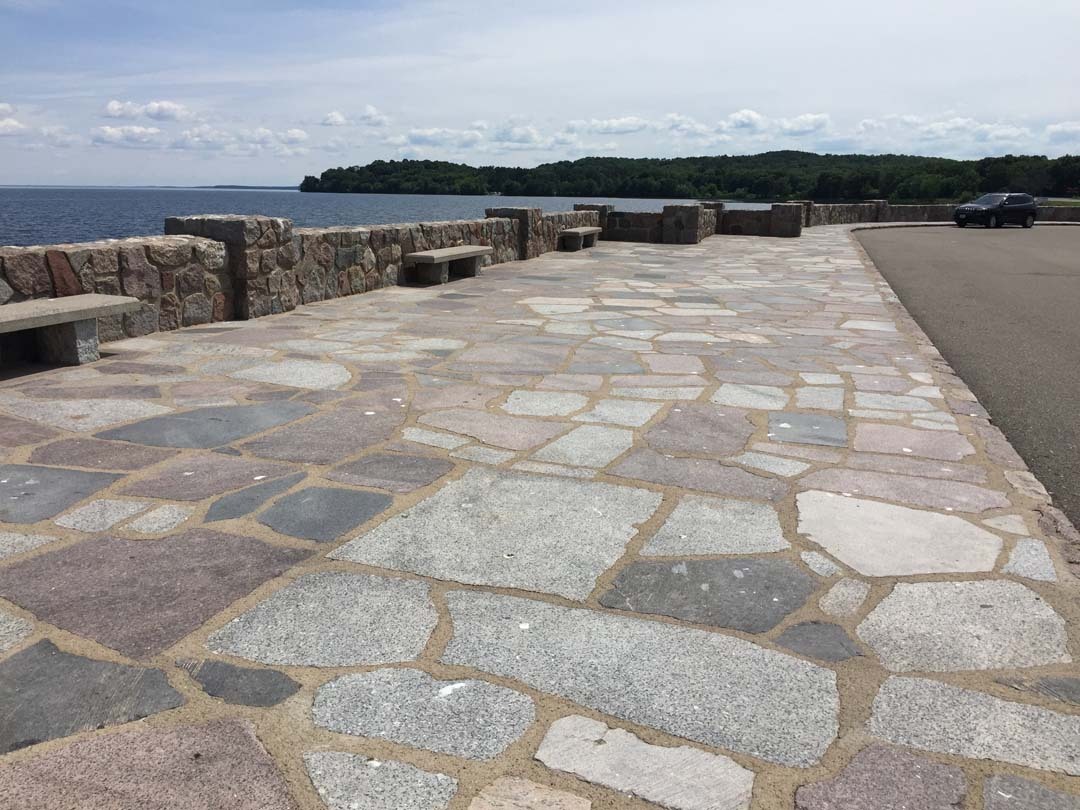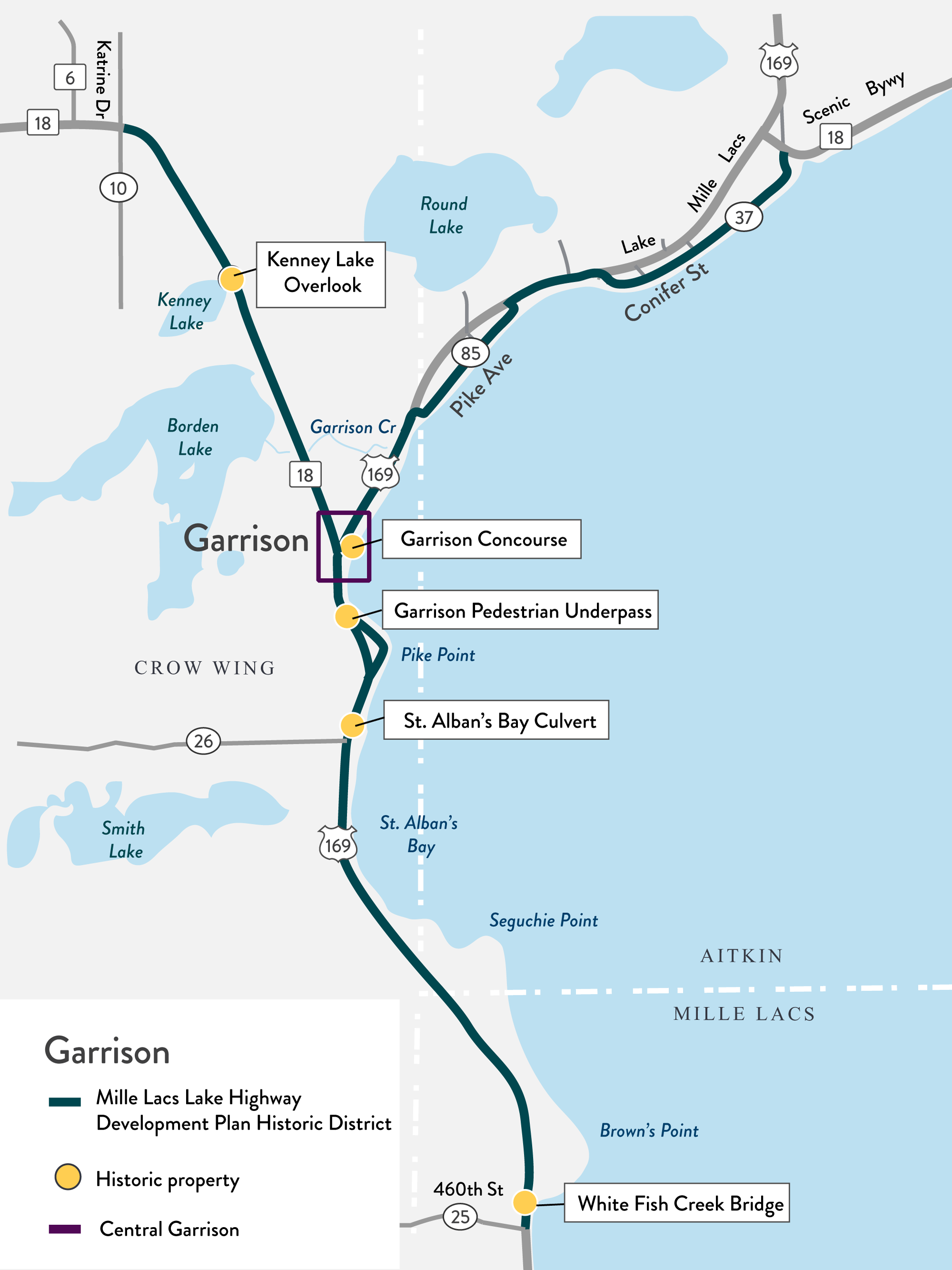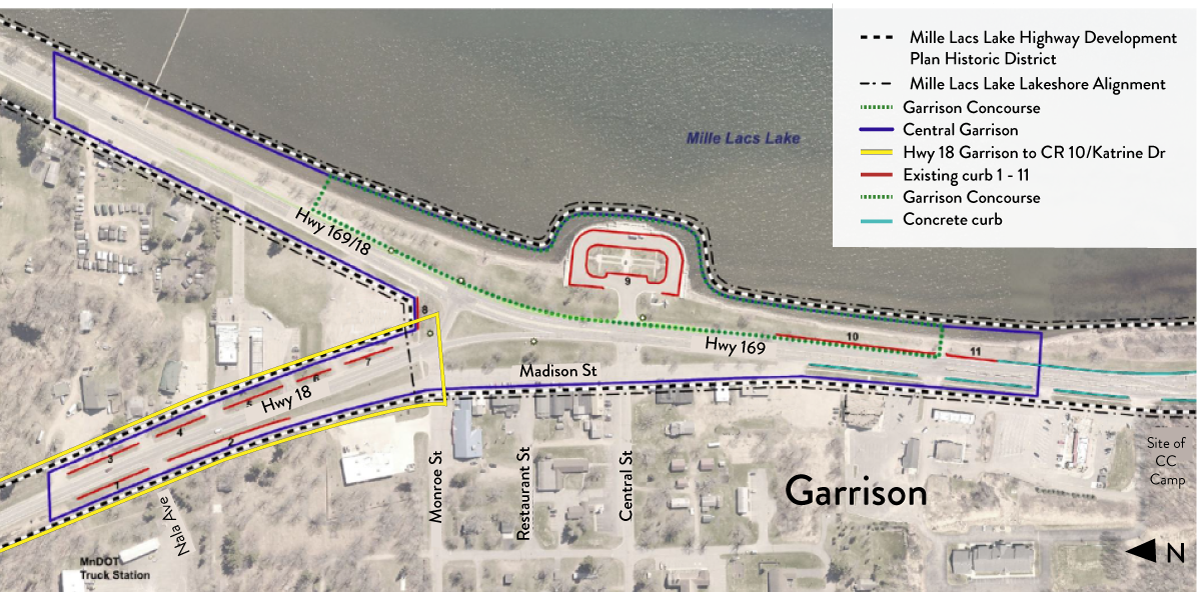Historic properties
MnDOT’s Cultural Resources Unit (CRU) identified seven historic properties within the Area of Potential Effects (APE) on the Hwy 169 Garrison project. Adverse effects are typically found when a project will alter the characteristics that qualify the property for inclusion in the National Register.

The Hwy 169 project in Garrison has the potential to adversely affect the properties through:
- Replacement of the Y junction with a roundabout
- Alteration of islands and other green spaces
- Addition of sidewalks
- Removal of granite curbing
- Removal of trees
- Addition of lights at the roundabout
Through consultation with the Minnesota Historic Preservation Office and other consulting parties, MnDOT CRU will resolve the project’s adverse effects and document that resolution through a Section 106 Memorandum of Agreement.
MnDOT’s Cultural Resources Unit (CRU) is reviewing the Hwy 169 project in Garrison under Section 106 of the National Historic Preservation Act of 1966. Section 106 requires federal agencies to consider the effects of their projects on historic properties. MnDOT conducts the review on behalf of the Federal Highway Administration.
Section 106 review includes:
- Delineate project’s Area of Potential Effects (APE)
- Identify properties within the APE that are listed in or eligible for inclusion in the National Register of Historic Places
- Assess the project’s potential to have “adverse effects” to historic properties
- Public outreach and engagement
- Meet with consulting parties to resolve any adverse effects
For more information on the process, visit the Advisory Council on Historic Preservation’s website.
Contact
If you would like to provide input on the project’s potential impacts to these historic properties or would like additional information on the Section 106 process for the Hwy 169 project in Garrison, please contact:
- Barbara Howard
Cultural Resources Unit
Barbara.Howard@state.mn.us
651-366-3636
1. Garrison Concourse
Adversely affected

Garrison Concourse, built between 1936 and 1939, is a state highway rest in central Garrison. It’s the centerpiece of the most extensive state highway roadside development project built by Civilian Conservation Corps and the Minnesota Highway Department. It’s a distinctive example of the collaboration between National Park Service designers and Minnesota landscape architect A.R. Nichols. Garrison Concourse is one of the most physically impressive of Minnesota’s trunk highway roadside development properties. It is an excellent, well-preserved, stylistic blend of formalism and the National Park Service Rustic Style and displays high-level craftsmanship. The Concourse continues to be a popular destination for visitors to Mille Lacs Lake and for recreational travelers on Hwy 169 and 18. Listed on the National Register of Historic Places, Garrison Concourse is a contributing resource to Hwys 169 and 18, Hwy 169: Mille Lacs Lake Lakeshore Alignment, and the Mille Lacs Lake Highway Development Plan Historic District. Learn more: mndot.gov/roadsides/historic/.
2. Garrison Pedestrian Underpass
No adverse effect
Built in 1938, the Garrison Pedestrian Underpass bridge carries Hwy 169 over an unnamed drainage stream on the west shore of Mille Lacs Lake in Garrison. The bridge is one of Minnesota’s best examples of a multi-plate arch bridge construction. It’s an excellent example of the National Park Service Rustic Style and displays the distinctive use of local granite and a high-level craftsmanship. The bridge is well-preserved and is one of four stone and concrete bridges built as part of the Mille Lacs Lake Highway Development Plan. The bridge is listed on the National Register of Historic Places and contributes to the Hwy 169: Mille Lacs Lake Lakeshore Alignment (XX-ROD-046) and the Mille Lacs Lake Highway Development Plan Historic District (XX-ROD-184). Learn more about the history of the Garrison Pedestrian Underpass (Bridge 5265)
3. St. Alban’s Bay Culvert
No adverse effect
St. Alban’s Bay Culvert, built in 1938-1939, carries Hwy 169 over a small drainage stream along St. Alban’s Bay on the west shore of Mille Lacs Lake. It’s an excellent example of the National Park Service rustic style and displays the distinctive use of local granite, built with high-level craftsmanship. The culvert is well-preserved and is one of four stone and concrete bridges built as part of the Mille Lacs Lake Hwy Development Plan. St. Alban’s Bay Culvert is listed in the National Register of Historic Places and contributes to Hwy 169: Mille Lacs Lake Lakeshore Alignment (XX-ROD-046) and the Mille Lacs Lake Highway Development Plan Historic District (XX-ROD-184). Learn more: St. Alban's Bay Culvert
4. Mille Lacs Lake Highway Development Plan Historic District
Adversely affected

The Mille Lacs Lake Highway Development Plan Historic District is a Y-shaped historic district that consists of about 11 miles of existing and former alignments of Hwys 169 and 18. The development plan was created between 1935 and 1941 as a joint effort between the Minnesota National Park Service of Highways and Civilian Conservation Corps to create a scenic, recreational parkway and to improve highway safety and aesthetics. Construction included highway realignment, roadside sloping and landscaping, and the construction of four stone and concrete culverts/small bridges, three wayside rests, and extensive highway development in central Garrison. Most of the structures are architecturally distinctive and readily recognizable as New Deal federal relief construction. The Mille Lacs Lake Highway Development Plan Historic District is individually eligible for inclusion in the National Register of Historic Places.
5. Hwy 18—Garrison to Co. Rd. 10/Katrine Dr.
Adversely affected
This four-mile segment of Hwy 18 was improved between 1935 and 1941 as part of the Mille Lacs Lake Highway Development Plan, a joint project of the National Park Service, the Civilian Conservation Corps, and the State of Minnesota to develop a scenic, recreational parkway on and near Mille Lacs Lake. Although it is not individually eligible for inclusion in the National Register, it contributes to the Mille Lacs Lake Highway Development Plan Historic District (XX-ROD-184).
6. Hwy 169—Mille Lacs Lake Lakeshore Alignment
Adversely affected
The Hwy 169 Mille Lacs Lake Lakeshore Alignment is a 23-mile road on the west and northwest shore of Mille Lacs Lake. It includes both existing and early segments of Hwy 169. The roadway along the west shore of Mille Lacs Lake became part of the popular “Minnesota Scenic Hwy” in 1916. The highway was improved to state and federal standards in 1920, just before the trunk highway system was established. For many decades, the lakeshore highway was instrumental to the development of tourism in the Mille Lacs region. It was one of the state’s busiest recreational highways and served as a major route from the Twin Cities to both Brainerd and the Iron Range. Portions of the road were improved during the Great Depression as a unique scenic, recreational parkway designed to encourage tourism and improve highway safety and aesthetics. The Hwy 169 Mille Lacs Lakeshore Alignment is individually eligible for inclusion in the National Register of Historic Places. The project will adversely affect the Hwy 169 Mille Lacs Lake Lakeshore Alignment.
7. Hwy 169 and 18—Central Garrison
Adversely affected
Hwy 169 and 18 in Central Garrison include extensive development completed between 1935 and 1941. The improvements were an important accomplishment of the Mille Lacs Lake Highway Development Plan, a joint project of the National Park Service, the Civilian Conservation Corps, and the State of Minnesota to develop a scenic, recreational parkway on and near Mille Lacs Lake. Hwys 169 and 18 in Garrison are individually eligible for inclusion in the National Register of Historic Places and contribute to the Hwy 169: Mille Lacs Lake Lakeshore Alignment (XX-ROD-046) and the Mille Lacs Lake Highway Development Plan Historic District (XX-ROD-184).

*Photographs and historic property descriptions above are based on reports and inventory forms prepared for MnDOT Cultural Resources Unit and Gemini Research
